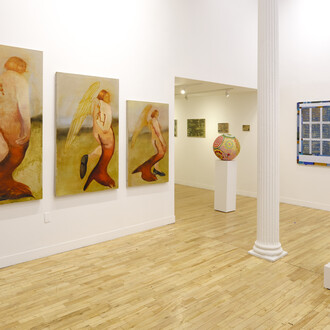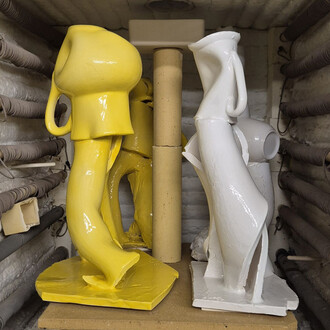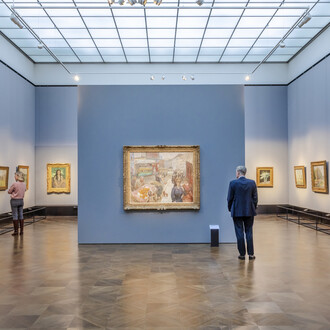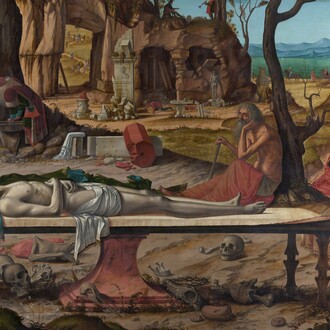A group exhibition showing the very best of Pangolin London artists. This dramatic show features a variety of large-scale pieces including works by the gallery’s staple artists Kenneth Armitage, Ralph Brown, Jon Buck, Ann Christopher, Geoffrey Clarke, Terence Coventry and Merete Rasmussen among others, demonstrating the variety and quality of work produced by the artists the gallery represents.
Pangolin London is one of the city’s few galleries dedicated to exhibiting sculpture and since opening in 2008, continues to deliver a rotating exhibition programme of the highest quality.
Kenneth Armitage was born in Leeds, England, in 1916 and studied at Leeds College of Art, like Henry Moore and Barbara Hepworth before him. Further study in london was followed by army service during the 2nd World war. After the war he ran the sculpture department at the Bath Academy at Corsham. His work came to international prominence in the 1952 British Pavillion at the Venice Biennale where he exhibited along his contemporaries Reg Butler, Lynn Chadwick, Bernard Meadows and others who were championed as the 'New Bronze Age' sculptors. In 1953 he became the first Gregory Fellow in Sculpture at Leeds University. Throughout the 50's and 60's he exhibited widely and was collected by all the major museums worldwide. He also became a visiting professor in Venezuela, the USA and Germany. He was elected a Royal Academician in 1995.
Ralph Brown was born in Leeds, and is the younger contemporary of the eminent group of Yorkshire sculptors that include Kenneth Armitage, Barbara Hepworth and Henry Moore. He studied at Leeds College of Art, where both Moore and Hepworth attended, and the Royal College of Art where he was taught by Frank Dobson, John Skeaping and Leon Underwood. During the fifties Brown’s work attracted much critical acclaim and was shown alongside his contemporaries Armitage, Turnbull and Paolozzi. Throughout the 1960s and 1970s, when abstraction prevailed in British sculpture, Brown remained faithful to the human figure and he has long stood out among his contemporaries as the master of human anatomy. Brown was elected a Royal Academician in 1972 and his work can be found in many public collections including the Arts Council of Great Britain, Bristol City Art Gallery, Leeds City Art Gallery, The National Museum of Wales and the Tate Collection, London.
Jon Buck’s lively human, bird and animal sculptures look back to a time when animal monuments were worshipped, and explore the human need for cultural icons. Eschewing fashion from the start of his career, Jon Buck has pursued his own interests in primitivism and the links between the physical processes of ‘making’ and the emotional and psychological content of his compositions. Indeed Buck likes to think of his sculptures as acting as intercessors between our contemporary intellectual selves and a more ancient, unconscious self that connects with our primitive, fundamental nature. Through the reduction of detail to simple line and volume, Buck gives his ideas a direct expression. His bold and joyful use of colour enhances our primary response to each piece and also gives each imagined creature or goddess a playful nature which is often reflected in its title. Drawing directly on to the form reinterprets the shape and creates a dialogue between the sculptural volume of the piece and the image represented by line. Interestingly it also sets up a visual tension of the surface with the complimentary colours vibrating optically as the line cuts through the mass.
Ann Christopher studied at Harrow School of Art from 1965 to 1966 then went on to the West of England College of Art from 1966 to 1969. Christopher’s first solo exhibition was held at the Mignon Gallery, Bath in 1969. Subsequent solo exhibitions were held throughout the 1970s and in 1989 she was given a retrospective of work produced between 1969 and 1989 at the Dorset County Museum and Art Gallery. Christopher has exhibited in numerous group exhibitions from 1969, both nationally and internationally. Much of Christopher’s work is from commissions, both public and private.
Christopher won first prize in the Harrison-Cowley Sculpture Competition in 1968. In 1971 she won the Peter Stuyvesant Award and was a prize winner in the Daily Telegraph Magazine Young Sculptors Competition. In 1973 she received a Birds Charity Award and an Arts Council Award, Thornton Bequest, and in 1976 a South West Arts Award. More recently, she was awarded Silver Medal for Sculpture of Outstanding Merit by the Royal Society of British Sculptors (1994) and the Otto Beit Medal of Sculpture of Outstanding Merit (1997). Christopher was elected a member of the Royal Academy in 1980 and a Fellow of the Royal Society of British Sculptors in 1992. She is represented by Pangolin London, and lives and works near Bath.
Geoffrey Clarke studied at Preston School of Art, Manchester School of Art and Lancaster and Morecambe School of Arts and Crafts before finally attending the Royal College of Art in 1948 to 1952. Clarke originally enrolled at the RCA on the Graphic Design course but soon transferred to the Stained Glass department. This graphic tendency combined with an ability to devote his skill to different materials shaped his ongoing artistic development. Clarke was propelled to prominence at the 1952 Venice Biennale, showing alongside Lynn Chadwick, Kenneth Armitage, William Turnbull, Eduardo Paolozzi, Bernard Meadows and Robert Adams, which was the catalyst for what became a British sculptural renaissance. After a meteoric rise, Clarke became the most commissioned British sculptor of his era, including the impressive nave windows at Coventry Cathedral. In the 1960s, he pioneered a new technique, casting in aluminium using expanded polystyrene, allowing him to carry out large scale commissions in his own foundry. Clarke’s work is included in the collections of the Arts Council of Great Britain, the Tate Collection and the Victoria & Albert Museum.
Terence Coventry’s talent was recognised from a young age and he gained early admittance to Stourbridge School of Art, where he was taught by Keith Leonard, who later became Hepworth’s assistant. Coventry went on to study at the Royal College of Art, however his frustration after his request to change from the painting to sculpture course led him to leave London and find his second career as a farmer on the Cornish coast. Subjugating his natural talent and artistic ability for long hours on tractors, complete sculptural images repeatedly formed in Coventry’s mind. Eventually, these thoughts erupted into three dimensions, unencumbered by fashion or trend, to create sculptures that are intimately personal. The power behind Coventry’s sculpture is his strong affinity with the subjects he creates. Rooted in a strong figurative tradition, his sculpture explores animals familiar to him such as birds, bulls, cows and boars and he eloquently captures both their ruggedness and gentleness, their movement and behaviour. Through a harmonious synthesis of these contrasting facets, Coventry expresses his fundamental relationship with his environment and produces images of great power and tenderness.
Merete Rasmussen was born in Copenhagen and brought up in Sweden. Returning to Denmark to study at the Designskolen Kolding she was inspired by the iconic designs of fellow Danes, Arne Jacobsen and Verner Panton. During her studies she travelled widely with the sculptural sand dunes of Namibia having a particularly potent effect. Talking about the wider interests in her work Merete says:
"I am interested in the way one defines and comprehends space through physical form. My shapes can represent an idea of a captured movement, as a flowing form stretching or curling around itself, or the idea can derive from repeated natural forms or even complex mathematical constructions. Different form expressions appeal to me and results in my continuous exploration with many different variations: soft but precise curves, sharp edges, concave surfaces shifting to convex; the discovery and strength of an inner or negative space. I am intrigued by the idea of a continuous surface, for example with one connected edge running through an entire form."
Pangolin London
90 York Way, Kings Place
London N1 9AG United Kingdom
Ph. +44 (0)20 75201480
gallery@pangolinlondon.com
www.pangolinlondon.com
Opening hours
Monday - Saturday
From 10am to 6pm
Related images
- Bruce Beasley, Knight’s Gambit, 1991, bronze, courtesy Pangolin London/Steve Russell
- Terence Coventry, Silver Jackdaw, 2008, sterling silver, courtesy Pangolin London/Steve Russell
- Lynn Chadwick, Watcher XII, 1961, bronze, courtesy Pangolin London/Steve Russell
- Merete Rasmussen, Blue Form, 2013, ceramic with coloured slip, courtesy Pangolin London/Steve Russell
- Steve Hurst, 29th Division, 1997, mixed media, courtesy Pangolin London/Steve Russell
- Jon Buck, Mind Map, 2009, bronze, courtesy Pangolin London/Steve Russell














